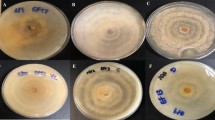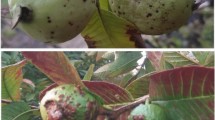Abstract
The effects of temperature and pH on the growth and sporangial production of isolates from each of the four known races of Phytophthora clandestina Taylor, Pascoe & Greenhalgh were investigated. Mycelial growth occurred at temperatures from 10 to 30°C and pH 3.5 to 9.0 with highest growth rates of all isolates being at 25°C with a pH of 6.0–6.5. Sporangial production was greatest between 20 and 25°C and pH 5.0–7.0 with all races. However, sporulation occurred over a temperature range from 10 to 30°C and from pH 4.0 to 9.0 with all isolates. There were no consistent differences between the four pathogenic races of P. clandestina in their relative growth rate or extent of sporangial production over a range of temperatures and pH values.
Similar content being viewed by others
References
Duniway JM (1983) Role of physical factors in the development of Phytophthora diseases. In ‘Phytophthora: its biology, taxonomy, ecology and pathology’. (Eds DC Erwin, S Bartnicki-Garcia and PH Tsao) pp. 175–187. (American Phytopathological Society: St Paul, MN)
Eskdale JW, Murray GM (1991) Baiting to detect root rot pathogens of subterranean clover. In Australasian Plant Pathology Society 8th Conference, 7–11 October 1991, Sydney University, Program and Abstracts, pp. 14. Australasian Plant Pathology Society: Sydney.
Flett SP (1994) Studies on Phytophthora clandestina, the cause of taproot rot in subterranean clover. 1. Evidence for physiological specialisation in Phytophthora clandestina. Australian Journal of Experimental Agriculture 34, 1125–1129.
Greenhalgh FC (1992) Studies on the etiology and significance of root diseases of subterranean clover, and the histopathology and control of Phytophthora root rot. PhD Thesis, La Trobe University, Victoria.
Greenhalgh FC, Taylor PA (1985) Phytophthora clandestina, cause of severe taproot rot of subterranean clover in Victoria, Australia. Plant Disease 69, 1002–1004.
Purwantara A, Flett SP, Keane PJ (1997) The effect of temperature on the growth of Phytophthora clandestina and infection of subterranean clover cultivars. Australasian Plant Pathology 26, 109–114.
Ribeiro OK (1983) Physiology of asexual sporulation and spore germination in Phytophthora. In ‘Phytophthora: its biology, taxonomy, ecology and pathology’. (Eds DC Erwin, S Bartnicki-Garcia and PH Tsao) pp. 55–70. (American Phytopathological Society: St Paul, MN)
Taylor PA, Greenhalgh FC (1987) Significance, causes and control of root rots of subterranean clover. In ‘Temperate pastures: their production, use and management’. (Eds JL Wheeler, CJ Pearson and GE Robards) pp. 249–251. Australian Wool Corporation/Commonwealth Scientific and Industrial Research Organisation: Melbourne.
Taylor PA, Barbetti MJ, Wong DH (1985a) Occurrence of Phytophthora clandestina in Western Australia. Plant Protection Quarterly 1, 57–58.
Taylor PA, Pascoe IG, Greenhalgh FC (1985b) Phytophthora clandestina sp. nov. in roots of subterranean clover. Mycotaxon 22, 77–85.
Wong DH, Barbetti MJ, Sivasithamparam K (1985) Fungi associated with root rot of subterranean clover in Western Australia. Australian Journal of Experimental Agriculture 25, 574–579.
Wong DH, Barbetti MJ, Sivasithamparam K (1986a) Behaviour of Phytophthora clandestina propagules at a field site in Western Australia. Australian Journal of Soil Research 24, 485–491.
Wong DH, Sivasithamparam K, Barbetti MJ (1986b) Soil behaviour of Phytophthora clandestina. Phytopathology 116, 67–73.
Wong DH, Sivasithamparam K, Barbetti MJ (1986c) The influence of environmental factors on the growth and survival of Phytophthora clandestina. Canadian Journal of Microbiology 32, 553–556.
Wong DH, Sivasithamparam K, Barbetti MJ (1986d) Influence of soil temperature, moisture and other fungal root pathogens on the pathogenicity of Phytophthora clandestina to subterranean clover. Transactions of the British Mycological Society 86, 479–482.
Author information
Authors and Affiliations
Corresponding author
Rights and permissions
About this article
Cite this article
Simpfendorfer, S., Harden, T.J. & Murray, G.M. Effect of temperature and pH on the growth and sporulation of Phytophthora clandestina. Australasian Plant Pathology 30, 1–5 (2001). https://doi.org/10.1071/AP00054
Received:
Accepted:
Published:
Issue Date:
DOI: https://doi.org/10.1071/AP00054




